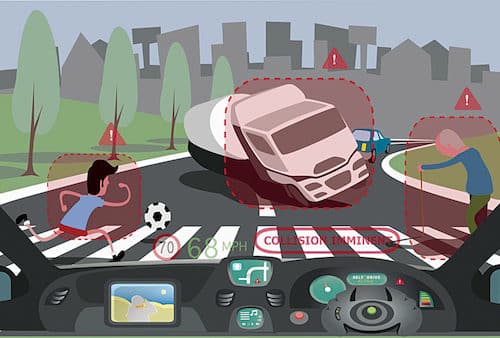An autonomous vehicle (AV) relies on devices and components that exchange, share and interpret data. Interoperability of these devices and components ensures that these can form an integrated ecosystem within the vehicle, seamlessly communicating with each other without sacrificing performance.
Autonomous vehicle (AV) testing and validation are vital for making AVs safe for humans on the road. Traditional prototype-based testing takes time and large budgets, so engineers need to take advantage of physics-based and virtual reality (VR) simulations. These digital tools will enable engineers to overcome the challenges of testing and validating AV designs.
As traffic can be erratic, AVs will encounter unique scenarios every day, like a car running on the wrong side on the road. Testing will check the AVs’ reaction to such unique scenarios. On-road prototypes would rarely experience these conditions, and setting up such scenarios would be dangerous and costly. Instead, testing and validating AVs for such scenarios can be done using simulation for fast and cost-effective results.
Vehicles controlled by artificial intelligence (AI) need to be tested for every conceivable iteration of traffic, conditions and signage. As physically testing these scenarios can be risky to pedestrians and other vehicles, engineers can explore the AV domain of validity using parameterisation, simulation and VR. This will help run multiple permutations in a fraction of the time for different stop-sign scenarios automatically.
AV testing parameters
AVs need a wide array of sensors to get a clear picture of the world around them, including cameras, lidars, radars, thermal cameras, GPSes and more. Glare can affect various sensors and, hence, these are tested and validated under various conditions using simulation where one, or multiple, sensors fail. Simulations can help model faulty sensors to determine how the AVs will handle such situations.

“Safety standards for AVs are absolutely critical for public acceptance of the new technology,” says Greg McGuire, associate director of M-city autonomous vehicle testing lab at University of Michigan. “Without them, it is hard to decide whether self-driving cars are safe, and to gain public trust. Earning that trust requires developing standards through an open process that the public can scrutinise, and may even require government regulation.”
Main aspects of testing technology are to ensure sensors are providing correct feedback, so AI can be sure to have the correct information to process.
Testing machine learning systems have become a little more complicated. These are based on a neural network, which is nothing more than layered algorithms with variables that are adjusted after training the system. Training involves feeding data to the systems until we are able to arrive at a result that is within our degree of accuracy for known good results.
Environment testing
Researchers are building tools and techniques to generate driving conditions and issues that maximally impact AV safety and performance. These will help find a large number of safety-critical scenarios where errors can lead to accidents without having to enumerate all possibilities on the road.
A library of Edge cases has been developed for testing autonomous driving systems repeatedly in augmented reality (AR)-based simulations. Data compiled from drivers operating vehicles jam-packed with sensors helps design such custom-built simulation environments that reflect how drivers actually react and behave on the road. This improves autonomous driving systems’ performance with each repetition.
On-road testing allows vehicles and their various parts to be tested in real-world conditions, subjecting them to elements like weather, geography, light or darkness, road conditions, tunnels, on-ramps, speed changes, traffic lights, infrastructure and more. These real-world analyses can be valuable in assessing safety and performance in a controlled manner, providing a realistic view of lifespan of the products. By combining lab and ground testing, evaluations can provide a more complete picture to fully understand how the durability test affects performance of the products.
Assessing communication technologies
Safety of AVs is critical to their success in the marketplace and in society. Wireless communication technologies offer limitless opportunities within the transportation sector. But this requires extensive validation testing to ensure safety and performance of connected and automated vehicles. It includes checks to ensure functionality of vehicles and their components, and their interaction with other cars and wireless technologies such as cellphones, Bluetooth, Wi-Fi, etc. There are several other considerations to address when it comes to developing and implementing testing.
Geographical elements such as solar flares, buildings, tunnels, canyons or simply reception can impact connection and reception of the GPS signal in an automated or connected vehicle. So, it is important to test additional sensors and algorithms, and their ability to use data acquisition hardware and real-time kinematic systems to track true vehicle position in these situations.
For vehicles in motion, communication will be a constant concern, as they will increasingly need to interact with infrastructure and other smart devices. Dedicated short-range communications is a wireless technology that allows automobiles to conduct this communication. Its components testing includes laboratory and real-world testing to ensure their interoperability, connectivity, security, performance and electrical safety. On-road testing allows evaluation of components within a vehicle and tests their interaction while operating in the intended environment along with communication established with other road-side units.
Electronic components testing
Evaluation of automated systems in automobiles needs testing of various sensing technologies like lidar, radar and cameras. Lidar systems produce data that is highly beneficial to the automated vehicle’s algorithms. Accelerated stress testing provides a repeatable method for improving its design robustness and eliminating issues. It simulates real-life conditions as well as additional and elevated conditions to gather data that helps ensure product functionality and reliability.
Radar can detect objects depending on their size, shape and material composition. So, objects may go undetected or be incorrectly identified if they are too thin or transparent to the radar frequency or are non-conductive. It may also detect objects wrongly if there are elevation changes, such as entrance and exit ramps, or when the road has a sharp curve because objects have unique geometry.
Most automated vehicles utilise cameras for object detection; however, cameras function best under good lighting conditions and are less reliable during vehicle transitions from one lighting condition to another. For example, when the vehicle emerges from the tunnel during daytime, thus moving from dark to light, the camera may not work as well.
So, the camera needs to undergo extensive performance testing in the lab to ensure its performance, both as a standalone device and as an integrated component within the vehicle’s vision system. Also, it should be tested for weather conditions, such as how it will operate with raindrops or snow over the lens.
Interoperability tests for a seamless performance
An AV relies on devices and components that exchange, share and interpret data. Interoperability of these devices and components ensures that these can form an integrated ecosystem within the vehicle, seamlessly communicating with each other without sacrificing performance. Additionally, software testing of interoperability uses manual and simulated test processes to verify that the product meets all functional, performance, security and quality requirements.
Without clear standards and regulatory requirements, testing of automobiles and their components can be confusing. However, implementing testing in the lab as well as in the field can serve as a good starting point. As technology evolves, standards will begin to follow, making it essential to remain aware of proposed and approved developments, regulations and changes.







